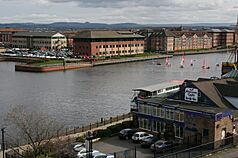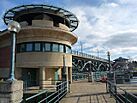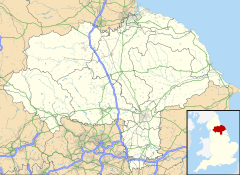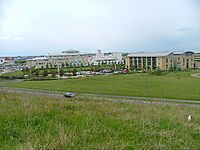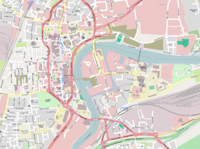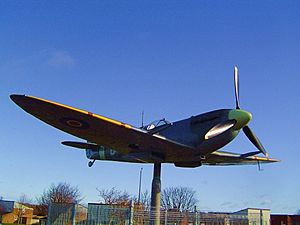Thornaby-on-Tees facts for kids
Quick facts for kids Thornaby-on-Tees
|
|
|---|---|
| Town and civil parish | |
|
From the top, Thornaby from across the River Tees, Tees Barrage, Town Hall, Infinity Bridge |
|
| Population | 24,741 (2011 census) |
| OS grid reference | NZ450180 |
| Civil parish |
|
| Unitary authority |
|
| Ceremonial county | |
| Region | |
| Country | England |
| Sovereign state | United Kingdom |
| Post town | THORNABY-ON-TEES |
| Postcode district | TS17 |
| Dialling code | 01642 |
| Police | Cleveland |
| Fire | Cleveland |
| Ambulance | North East |
| EU Parliament | North East England |
| UK Parliament |
|
Thornaby-on-Tees, often called Thornaby, is a town in North Yorkshire, England. It is part of the Stockton-on-Tees Borough Council area. In 2011, about 24,741 people lived here. Thornaby is located on the south side of the River Tees.
The town officially became a municipal borough in 1892, during the Victorian era. This means it got its own local government. Later, in 1968, it became part of the County Borough of Teesside. Then, in 1996, Thornaby became a civil parish again.
Today, the main part of Thornaby is built on what used to be Thornaby airfield. It is about 2 kilometres (1.2 miles) south-east of Stockton-on-Tees. It is also about 4 kilometres (2.5 miles) south-west of Middlesbrough.
Contents
Discovering Thornaby's Past
Ancient Times: Early Settlers
Thornaby has a very long history. People have found signs of early humans living here. One of the oldest finds is a stone axe, about 20 centimetres (8 inches) long. It dates back to the Mesolithic Period, around 3000 BC.
In 1926, a dugout canoe was found in the mud near Thornaby High Wood. Experts think it is from about 1600–1400 BC. An arrowhead from the Neolithic Period (around 3000 BC) was also found in a garden in Thornaby Village Green. These discoveries show that people have lived in this area for thousands of years!
The Danes Arrive: How Thornaby Got Its Name
The name Thornaby likely came about 800 AD. This was when Halfdene (Halfdan Ragnarsson), the King of the Danes, gave the land to one of his noblemen named Thormod. So, "Thormods-by" meant "Thormod's farmstead." The "-by" part of the name means "farmstead" or "village." Many other villages in the area, like Danby and Ormesby, also have this ending.
After the Battle of Hastings in 1066, William the Conqueror sent his nobleman, Robert I de Brus, north. Robert took control of the Cleveland area, which included Thornaby and Middlesbrough.
In 1069, King Sweyn II of Denmark defeated the Normans in York. William was very angry and promised to destroy all homes in the lands under Sweyn's control. This left much of north-east Yorkshire empty and barren.
The Domesday Book, a famous survey from 1086, mentions Thornaby five times. One entry says: "Robert Malet has these lands and they are waste." This suggests the area stayed undeveloped for a long time. The name "Thornaby" first appeared in 1665.
The Five Lamps of St Peter's Church
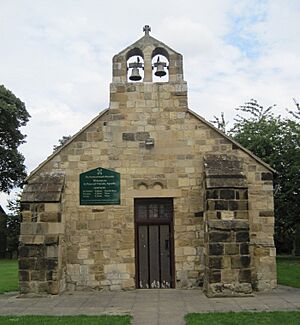
There's a story about Robert de Thormodbi. He was wounded during the Crusades in Acre. He promised to build a shrine to the Virgin Mary if he survived. He did survive! As part of his promise, a special niche for the Virgin Mary was placed in St Peter's Church. It was lit by five sanctuary lamps.
From Marshes to a Busy Town
In 1825, old Thornaby was a small village around St Peter's Church. The Thornaby Carrs (which were marshes) were sometimes used for horse racing. But this moved to Stockton Racecourse after the River Tees was straightened in 1810.
From 1825, new industries began to appear south of Stockton's port. This was because the Stockton and Darlington Railway had just opened. The first business was William Smith's pottery. Soon, shipbuilding and engineering companies also started up on the marshes. From 1840 until 1987, a big engineering company called Head Wrightson was a major employer in Thornaby.
The area growing on the south bank of the Tees was first called South Stockton. When Stockton's port industry moved to Middlesbrough, iron works replaced shipbuilding. A new railway line helped the area grow even more. A South Stockton railway station was built in 1882.
The new settlement grew as more people came to work in the new factories. It spread south along Thornaby Road, Westbury Street, and Mandale Road. South Stockton eventually merged with the old village of Thornaby. On October 6, 1892, they officially joined to form a municipal borough called Thornaby-on-Tees. South Stockton station was then renamed Thornaby. The Thornaby Town Hall was built in 1892 for the local government.
The Airfield: Planes, Spitfires, and Heroes
The first known flying in Thornaby happened in 1912. A farmer was paid to let an airshow use his field. One of the stars was Gustav Hamel, an early pilot. Later, between 1914 and 1918, the Royal Flying Corps used the fields as a stopover for planes.
Around 1925, plans began for a full-time airfield. The Air Ministry built an airfield south of the town, which opened on September 29, 1929. This was the second permanent airfield in Yorkshire. During World War II, RAF Thornaby was very important. It was used for attacking targets in Europe, anti-submarine patrols, training, striking enemy ships, dropping leaflets, and air-sea rescue missions.
608 (North Riding) Squadron
One of the most famous squadrons at RAF Thornaby was "Thornaby's own" 608 (North Riding) Squadron. It was formed in Thornaby on March 17, 1930. It served in both Coastal and Bomber Commands during World War II. After the war, the squadron was re-formed in Thornaby in 1946 and stayed there until it disbanded in 1957. The squadron's special flag, which shows its battle honors, is kept in York Minster.
Thornaby's Growth After the Airfield
The last planes left the airfield on October 1, 1958. In 1962, most of the land was bought by Thornaby-on-Tees Borough Council.
Thornaby then became part of the County Borough of Teesside (1968–1974). After that, it joined the Borough of Stockton-on-Tees. In the 1960s and 1970s, the airfield was transformed. Its old buildings were taken down, and new houses, shops, offices, a sports centre, and a light industrial estate were built. This industrial estate was the first in the area and was called Teesside Industrial Estate.
Many things in Thornaby remind people of its aviation past. Streets, buildings, and pubs are named after Royal Air Force aircraft, bases, and people. The Bader School, built on the old airfield, was named after and opened by Sir Douglas Bader in 1971. In 1976, a special stained glass window in St Paul's Church was dedicated to the RAF at Thornaby. In 1997, a statue was put up on Thornaby Road to honor everyone who served at RAF Thornaby.
In 2007, a full-size replica of a Supermarine Spitfire aircraft was placed on the roundabout where Thornaby Road, Bader Avenue, and Trenchard Avenue meet. Hidden under the roundabout is a part of one of the old runways!
Changes in Thornaby Town Centre
After the war, Thornaby's old town centre became less important. Many people moved to new homes on the old airfield. New shops, called the Pavilion, opened closer to where people lived. The old centre became cut off by the A66 road. The old industrial areas became Teesdale Business Park.
In the late 2000s, Thornaby Pavilion was chosen as the new town centre. Old housing around the shops was removed, and new shops were built to create a pedestrian high street. The new Thornaby town centre officially reopened on April 25, 2009. Some tall apartment buildings in the town centre have been taken down. There are also plans to demolish the former Npower offices and build a new swimming pool there. The old Golden Eagle Hotel is also set to be demolished.
Community and Fun in Thornaby
Thornaby has won several awards. In 2008 and 2011, it won the silver gilt award for best small cities in Northumbria in Bloom. Thornaby Cemetery won "Cemetery of the Year" in 2006.
On November 10, 2011, an R.A.F. Search and Rescue Sea King Helicopter visited Bader Primary School. This was to celebrate the 40th anniversary of Sir Douglas Bader opening the school. The day included visits from RAF Leeming and the Cleveland Mountain Rescue Team.
Thornaby holds its Yorkshire Day event every August. The annual Thornaby Show takes place in early September. More than 10,000 people are estimated to visit the show each year.
In January 2014, a McDonald's and an Asda supermarket opened. Teesside Park is a large shopping area located on what used to be a racecourse.
How Thornaby is Governed
Thornaby has two levels of local government. There is the Thornaby Town Council and the Stockton-on-Tees Borough Council. The town council is based at the Thornaby Town Hall on Mandale Road.
Thornaby's Administrative Journey
Thornaby was historically a small area in the ancient parish of Stainton. In 1863, a local government area called South Stockton was created. This area grew and in 1892, South Stockton and Thornaby officially merged to form the "Thornaby-on-Tees" municipal borough.
In 1968, Thornaby became part of the County Borough of Teesside. Then, in 1974, it joined the enlarged Stockton-on-Tees district. The Thornaby Town Council was created in 1995. In 1997, Thornaby became part of North Yorkshire for ceremonial purposes.
In 2012, the town council bought Thornaby Town Hall from the borough council. The hall was built between 1890 and 1892. It had been empty since 1968. Now, it is the main building used by Thornaby Town Council.
Places of Worship
Church of England
The Church of St Peter ad Vincula on the village green dates back to the 12th century. However, a church was there even at the time of the Domesday Book in 1086. The name "St Peter ad Vincula" means "St Peter in chains." This name comes from an old church in Rome. Grace Pace, the mother of famous explorer Captain James Cook, was baptised at St Peter's in 1702. The larger St Paul's Church serves most of the town today.
Sports and Recreation
Acklam Road Sports
Thornaby Cricket Club is located at Mandale Bottoms (near Acklam Road). It has been around since 1892. Their main teams play in the North Yorkshire and South Durham Cricket League.
Teesside Golf Club opened in 1901. It is part of the Teesside and District Union of Golf Clubs.
Thornaby FC is a football club that plays in the Northern Football League Division One. The club was started in 2000. They play their games at the Teesdale Park ground on Acklam Road.
Thornaby Road Sports
Thornaby and Ingleby Barwick Football Club (TIBS FC) was formed in 1997. They play in the North Riding Football League Division One. The club plays at grounds off Thornaby Road and trains at Conyers School.
Getting Around Thornaby
Train Travel
Thornaby railway station serves the town. Northern operates train services to places like Newcastle, Sunderland, Darlington, and Whitby. TransPennine Express offers direct services to Leeds, Liverpool, Manchester, and York. LNER also provides a direct service to York and London Kings Cross.
Road Connections
Thornaby is well-connected by major roads:
- The A19 runs east of the town, going north and south.
- The A66 is north of the town, heading west and east.
- The A174 goes south-east towards Whitby.
Bus Services
Arriva North East and Stagecoach provide bus services within Thornaby. For longer journeys, National Express and Megabus coaches operate from Middlesbrough bus station.
Education in Thornaby
Secondary Schools
Thornaby has three secondary schools: St Patrick's Catholic College, Thornaby Academy, and Westlands Academy.
College Education
Stockton Riverside College is located in Thornaby. It is a large college that offers further education to about 10,000 students. It is called Stockton Riverside College because it is near the former Stockton South settlement, which was on the south bank of the River Tees.
University Opportunities
Next to the college is Durham University's Queen's Campus. This campus was started in 1992 as a joint project between Durham and Teesside universities. In 1998, it became fully part of Durham University. In 2019, Durham University moved its colleges and departments from Queen's Campus to Durham city. The campus is now used as an International Study Centre.
Famous People from Thornaby
- Grace Pace was the mother of the famous explorer Captain James Cook.
- Pat Barker is an award-winning author who lived in Thornaby. She is known for her "Regeneration Trilogy" of books about World War I. One of her books, The Ghost Road, won the Man Booker Prize in 1995.
- Holly Hagan is a TV personality who was born in Thornaby. She was one of the original stars of the MTV show Geordie Shore.
- Richard Griffiths was an actor born in Thornaby. He was well-known for playing Vernon Dursley in the Harry Potter movies. He also played Uncle Monty in the film Withnail and I. He won many awards for his acting in the film The History Boys.
- Paul Curran is a championship cyclist who was born in Thornaby.
- Norma Farnes grew up in Thornaby. She became the manager for famous comedians Spike Milligan and Eric Sykes. Norma has also written and edited several successful books.


